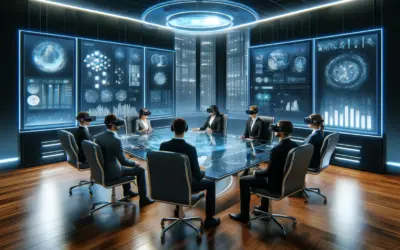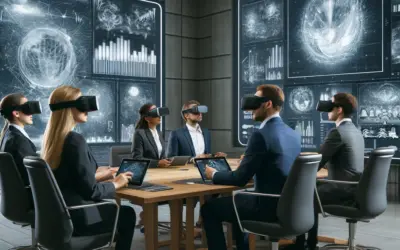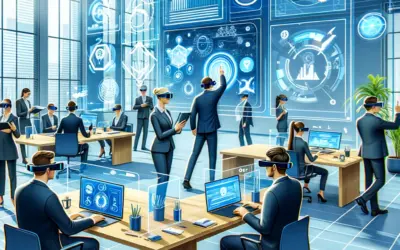The Rise of the Metaverse in Business: An Overview of Enterprise Applications
The concept of the Metaverse, a collective virtual space created by the convergence of physical and digital realities, is quickly becoming more than just a buzzword within the business community. This emerging domain offers vast opportunities for companies to innovate, collaborate, and connect with customers in unprecedented ways. Understanding how enterprises can leverage the Metaverse is essential for staying competitive in a rapidly evolving digital landscape.
Integrating Virtual Spaces into Real-World Business Operations
The Metaverse is redefining the approach to everyday business operations. Companies are exploring virtual environments where employees can interact in real time, despite geographical barriers. This can significantly enhance collaboration and creativity, allow diverse teams to work together seamlessly, and open up possibilities for virtual offices and events that were previously limited to physical locations. Moreover, businesses are finding that these virtual spaces can lead to reduced operating costs and increased efficiency.
Training and Development within the Metaverse
Education and training are among the most promising applications of the Metaverse in enterprise settings. Traditional methods of learning can be complemented with immersive, interactive experiences that simulate real-life situations. The Metaverse enables employees to practice skills and handle complex scenarios without the risk or cost associated with physical training environments.
Onboarding and Professional Growth
When it comes to onboarding new employees, the Metaverse can create an engaging and welcoming experience. New hires can learn about their role and the company culture through interactive simulations and gamified environments. This can significantly shorten the learning curve and help build a strong sense of belonging from the onset.
Revolutionizing Customer Engagement and E-commerce
The potential for transforming customer experiences within the Metaverse is vast. E-commerce sites are already beginning to experiment with virtual storefronts that allow customers to browse and interact with products in a 3D space. This digital transformation creates a rich, engaging shopping experience that rivals the physical world and opens up new possibilities for personalized customer service.
Creative Marketing Opportunities
Marketing strategies are also evolving with the rise of the Metaverse. Businesses have the opportunity to launch creative, interactive campaigns that immerse users in the brand’s narrative. Instead of simply viewing ads, customers can participate in brand experiences, leading to deeper emotional connections and potentially stronger brand loyalty.
Challenges and Considerations for Businesses Entering the Metaverse
Despite the exciting potential, integrating the Metaverse into business models comes with challenges. Companies must consider technological, legal, and ethical implications. It’s crucial to have robust cybersecurity measures in place to protect sensitive data and ensure user privacy. As standards and regulations around the Metaverse are still developing, businesses must stay informed and adaptive to navigate this new frontier effectively.
Virtual Collaboration Spaces: Revolutionizing Remote Work in the Enterprise Metaverse
In recent years, the concept of remote work has transformed from a luxury into a necessity for many organizations. With the birth of sophisticated virtual collaboration spaces, the ability to work together from disparate locations has seamlessly entered the domain of the enterprise metaverse. These virtual environments provide a three-dimensional space where employees can interact, brainstorm, and execute projects as if they were in the same physical office. The rise of enterprise metaverse platforms has led to a groundbreaking shift in workplace dynamics, fostering a new era of productivity and connectivity among distributed teams.
The Essence of Interaction in Virtual Workspaces
In the metaverse, virtual collaboration is not just about sharing files or sending messages; it’s about recreating the essence of human interaction. Utilizing advanced technologies such as VR headsets and AR tools, these virtual workspaces allow for gestures, facial expressions, and body language to be part of the digital conversation. This level of interaction engenders a sense of presence and community among remote workers, which is essential for maintaining team cohesion and stimulating collaboration. Additionally, customizable avatars and virtual meeting rooms make each session more engaging and less tiresome than conventional video calls or chats.
Enhancing Productivity with Immersive Tools and Features
Enterprise metaverse platforms are equipped with immersive tools that help to augment productivity. Task management becomes intuitive as team members can virtually ‘walk’ to different areas designated for specific projects or departments. Advanced features such as spatial voice chat allow conversations to happen naturally, mimicking the dynamics of physical office space. Furthermore, the integration of AI-driven assistants and data visualization tools within these spaces empowers teams to analyze complex information in a three-dimensional, interactive format, leading to improved decision-making and innovation.
Building a Sustainable Remote Work Culture
The enterprise metaverse isn’t just a technological evolution; it’s a cultural shift in the corporate world. By adopting virtual collaboration spaces, companies can build a sustainable remote work culture that emphasizes work-life balance, employee well-being, and environmental sustainability. Reduced commuting translates to less traffic and pollution, leading to a greener planet. Moreover, these virtual spaces help in leveling the playing field, providing equal opportunities for participation regardless of geographical limitations, thus promoting diversity and inclusiveness in the workplace. The virtual collaboration spaces encapsulate the future of work, where the digital and physical realms merge to create a holistic environment conducive to growth and success.
Leveraging the Metaverse for Training and Development in Enterprises
As the digital age evolves at a breakneck pace, enterprises are seeking innovative solutions to stay ahead in their respective industries. One such solution that is gaining traction is the metaverse, a collective virtual space created by the convergence of virtually enhanced physical reality and physically persistent virtual spaces. The potential of the metaverse for training and development is vast, offering immersive experiences that can transform how we learn, interact, and evolve in a corporate environment.
Enhanced Engagement with Immersive Learning Environments
Traditional training methods often struggle to engage participants and ensure knowledge retention. The metaverse emerges as a game-changer by introducing immersive learning spaces that allow employees to engage interactively with the training material. Through the use of avatars and 3D simulations, trainees can participate in scenarios that closely mirror real-world situations without the risks or costs associated with actual experiences. This hands-on approach facilitates better engagement, boosts retention rates, and makes the training process more enjoyable and effective.
Unlimited Scalability and Accessibility
With enterprises operating on a global scale, the ability to train employees across various locations is crucial. The metaverse offers unparalleled scalability, allowing companies to create a cohesive training program accessible to employees worldwide. Virtual environments in the metaverse are not limited by physical space, enabling a large number of participants to join simultaneously and engage in learning activities. This accessibility also empowers employees with flexibility, as they can access training modules at their convenience, irrespective of time zones or geographical barriers.
Real-Time Collaboration and Skill Development
The metaverse does not only centralize training experiences but also fosters real-time collaboration among the trainees. This shared virtual space allows employees from different departments or global offices to interact as if they were in the same room, working together on projects, solving problems, and exchanging ideas. This collaborative setting also encourages the development of soft skills such as communication, teamwork, and leadership – competencies that are highly valued in the modern workplace. Moreover, the quick feedback loop in virtual settings ensures that employees can learn from mistakes and successes promptly, contributing to a culture of continuous improvement.
Customization for Personalized Learning Experiences
One of the greatest advantages of the metaverse in training and development is the ability to tailor experiences to individual learners’ needs. Personalization in learning has been recognized as key to increasing engagement and effectiveness, and virtual training platforms in the metaverse can be easily customized to suit different learning paces, styles, and preferences. Adaptive learning paths can be created, which evolve based on trainee performance and ensure that each employee achieves their full potential. Such a high degree of personalization enables businesses to address specific gaps in skills and knowledge, making the workforce more adept and efficient.
In conclusion, the metaverse is revolutionizing the landscape of training and development within enterprises. The fusion of virtual and real worlds offers an unprecedented platform for immersive, scalable, collaborative, and personalized learning experiences. As technology advances and virtual spaces become more sophisticated, harnessing the power of the metaverse for enterprise training and development is not just innovative – it’s essential for continued growth and success in a rapidly digitizing global market.
Next-Gen Customer Interactions: The Role of the Metaverse in Consumer Engagement
The metaverse—a collective virtual shared space created by the convergence of virtually enhanced physical reality, augmented reality (AR), and the internet—is set to revolutionize customer interactions. Brands can forge deeper connections with their audience by providing immersive experiences that transcend traditional engagement platforms. The metaverse allows for a multifaceted approach to customer engagement, merging shopping, entertainment, and social interactions into a single, seamless digital environment.
Personalized and Immersive Consumer Experiences
In the metaverse, the lines between physical and digital are blurred, giving rise to personalized experiences that are both engaging and memorable. Companies can leverage customizable avatars, virtual storefronts, and interactive product demos to make every customer’s journey unique. These digital realms offer the ability for real-time interaction and personalization at scale, creating an environment where customer service and experience are not only responsive but also proactive.
Enhanced Brand-Customer Relationships
- Virtual Events: Companies can host virtual launches, fashion shows, or concerts, directly in the metaverse, connecting with consumers worldwide without the constraints of physical locations.
- Loyalty Programs: Evolve to include exclusive virtual goods, special metaverse experiences, and early access to digital products or events, fostering a new level of brand loyalty.
- Community Building: The creation of brand-centric communities within the metaverse can bolster customer engagement by encouraging interaction not just with the brand, but also peer-to-peer.
Embracing Interactivity and Feedback Loops
The metaverse’s real-time feedback mechanisms enable a dynamic interplay between consumers and brands. Product testing, live feedback during service experiences, and community-driven development are all viable within this new digital ecosystem. The insights gained can substantially influence product design, customer service strategies, and marketing campaigns, ensuring consumer needs are met with unprecedented agility.
Metaverse Commerce: Transforming B2B and B2C Transactions
The future of commercial transactions is being reshaped as the Metaverse blurs lines between physical and virtual worlds. Metaverse commerce, a term that marries the newfound virtual universe with the nuances of buying and selling, is poised to revolutionize how businesses interact with each other and with consumers. This shift is not just about the excitement of new technology but represents a fundamental change in the approach to sales, marketing, and customer engagement for both Business-to-Business (B2B) and Business-to-Consumer (B2C) models.
Revolutionizing B2B Interactions in the Metaverse
Traditionally, B2B transactions have been viewed as formal and driven by long-term relationships. However, Metaverse commerce brings a fresh and interactive dimension. Virtual showrooms and digital twins of products now allow companies to present and demonstrate complex offerings in a way that is both accessible and engaging. Networking events, too, are taking on a new form as conferences and trade shows move into virtual spaces, making connections more cost-effective and environmentally friendly.
- Enhanced Product Demos: Companies can leverage the Metaverse to provide immersive demonstrations that were previously impossible due to geographical or logistical constraints.
- Cost Savings: Virtual events reduce the need for travel, accommodation, and physical venue costs, presenting considerable savings and a boost to corporate sustainability efforts.
- Global Accessibility: With the barriers of distance removed, businesses can network and collaborate across continents as easily as they would within their local office.
Transforming the B2C Experience with Immersive Shopping
The B2C sector is experiencing a similar metamorphosis as consumers seek more personalized and interactive shopping experiences. Metaverse marketplaces offer a tantalizing glimpse into an era where customers can try on clothes, customize products, or walk through a digital replica of a store just as they might in the real world. Brands can create unique experiences that drive brand loyalty far beyond what’s possible with traditional online storefronts.
- Personalized Experiences: Brands can create tailored environments for shoppers, making recommendations based on their preferences and past behavior.
- Engagement and Interactivity: The Metaverse offers a platform for live events, product launches, and entertainment that can integrate shopping in unprecedented ways.
- Sensory Enrichment: Adding visual, auditory, and even haptic feedback to the shopping experience enriches customer interactions and can lead to better purchasing decisions.
As Metaverse commerce evolves, the potential for innovative, personalized, and immersive B2B and B2C transactions is limitless. The merging of advanced technologies with tried-and-tested business practices paves the way for a future that is not just high-tech, but also high-touch, centered around enhanced human experiences. Whether you’re a business looking to revolutionize your sales approach or a consumer eager for the next level of shopping enjoyment, the Metaverse holds paramount potential that is just beginning to be tapped.
Challenges and Considerations for Implementing Metaverse Strategies in Enterprise
The journey towards integrating metaverse strategies within an enterprise is rife with technical challenges. One of the primary hurdles is building a robust and scalable infrastructure capable of supporting complex virtual environments. This includes the deployment of advanced networking technologies, high-performance servers, and capable rendering capabilities to deliver seamless user experiences. Moreover, ensuring compatibility across various devices and platforms remains a key concern for a universally accessible metaverse.
Further complicating the landscape is the need for stringent data security measures. As enterprises venture into the metaverse, they must protect sensitive information and maintain privacy in alignment with regulatory compliance. Crafting a metaverse that is immune to cyber threats involves encrypting data transmissions, securing user identities, and deploying cutting-edge cybersecurity solutions. The trajectory of these efforts often requires significant investments and expertise in IT security, which can be a considerable barrier for some organizations.
Developing Interactive Content and User Engagement
The success of a metaverse strategy also hinges on the creation of engaging and interactive content. This means that enterprises must venture into the realms of 3D modeling, animation, and interactive design to craft immersive experiences that captivate users. The challenge lies in acquiring or nurturing talent that specializes in these areas, as well as the ongoing need to refresh content to keep up with user expectations and evolving virtual trends.
Aligning with Organizational Goals
For any enterprise seeking to implement metaverse strategies, it’s crucial that these efforts are in harmony with the broader organizational goals. Stakeholders must agree that the time, resources, and capital invested in the metaverse will contribute to the company’s growth, innovation, or customer engagement objectives. This often requires a cultural shift within the enterprise—to embrace digital transformation and the potential it brings for reshaping business models and customer interactions.
External factors also play a role in this consideration. For instance, while a metaverse presence may be trendsetting today, business leaders must critically assess its long-term feasibility and alignment with market trends. There’s a delicate balance between being an early adopter of metaverse technologies and ensuring that such strategies do not diverge from the demands and expectations of the company’s target audience.
Assessing Cost versus Return on Investment
The financial implications of adopting metaverse technologies cannot be overlooked. Organizations must conduct thorough cost-benefit analyses to ensure that the expected return on investment (ROI) justifies the expenses. These considerations include not only the initial setup and development costs but also ongoing maintenance, content creation, and potential revenue streams that the metaverse could unlock. Rigorous budget planning and financial forecasting are imperative to validate the economic viability of such a novel and ambitious endeavor.













0 comentarios